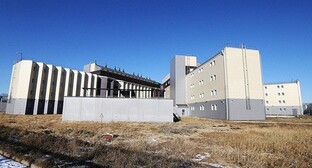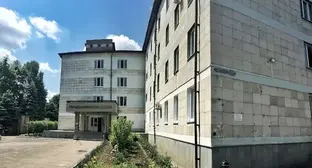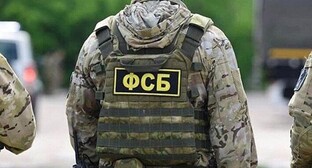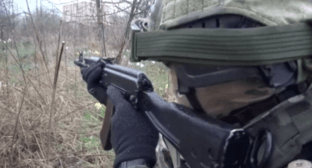29 April 2003, 12:48
Nalchik
Capital of Kabardino-Balkariya, 1873 km south-south-east of Moscow. Located on the foothills of the Greater Caucasus (at the height of about 500 m above the sea level), on the Nalchik River (the basin of the Terek). The climate is moderately continental. Winter is mild, with little snow and unstable snow cover; the temperature in January averages to -4?С. Spring is colder than autumn, early, with abundant precipitations. Summer is very warm, rather dry, with a plenty of clear sunny days; July temperature averages to 24-25?C; daily variations of temperature are considerable. Autumn is warm, dry, with a plenty of sunny days; October temperature averages to 9?C. Precipitations of about 600 mm a year, primarily in spring and summer.
Terminal of the railway branch (41 km) starting from the station of Kotlyarevskaya in the Prkohladnaya -- Beslan - Gudermes line. Highway (Rostov-on-Don- Baku). Airport. Population (1992 est.) 242.3 thousand, (1897 est.) 5 thousand, (1939 est.) 48 thousand, (1959 est.) 88 thousand, (1970 est.) 146 thousand, (1979 est.) 207 thousand.
In 1743, an aul (village) of the Toglans was founded at the site of Nalchik. Since 1808, it was the administrative and political centre of Kabarda, the residence of Kabardian princes. In 1817, the Russian fortress of Nalchik in the Caucasian boundary line was erected here. In 1838, a military village was founded near the fortress, converted in 1871 into a sloboda (settlement), which became the centre of the Nalchik okrug of Terek oblast (province). In 1921, Nalchik received the status of the city functioning as the centre of Kabardian Autonomous Oblast (Province), and since 1922, of Kabardino-Balkarian Autonomous Oblast (Province); in the 1936-1991s, it was the capital of the Kabardino-Balkarian АSSR (in the 1944-1957s, the Kabardian АSSR).
During the Great Patriotic War of 1941-1945, Nalchik was occupied by Nazi troops and heavily destroyed (October 1942 - January 1943).
By the beginning of the 1990s, Nalchik turned into a multifunction centre with diversified industry (about 50% of all industrial production of the republic). By that time, the city had machine industry (PО Sevkavelektronmash, PО Sevkavelektropribor; a telemechanical instrumentation factory, a semiconductor device plant, a high-voltage instrumentation factory, an engineering plant, a machine tool plant, etc.), non-ferrous metallurgy (a metal works producing tungsten anhydride and molybdenium concentrate), light industry (the Iskozh integrated works making rubberised raincoat fabric, etc.; a clothes factory, etc.), flavouring industry and production of building materials.
Nalchik has Kabardino-Balkarian Research Institute of History, Language, Folklore, Literature and Economy, High-Level Geophysical Research Institute, several planning and designing institutes. Kabardino-Balkarian University, the Agrarian Institute, the Institute of Arts. There are two theatres in city (the drama and the musical one), a philharmonic society, a museum of local lore (founded in 1920), a museum of fine arts (founded in 1960). The memorial house of the Russian and Ukrainian writer Marko Vovchok (M.A. Vilinskaya-Markovich, 1833-1907, buried in Nalchik).
Nalchik is the centre of tourism and mountain climbing. This city is the starting-point of routes to the areas around Mount Elbrus, Chegem water-falls, Goluboye Lakes, etc.
Before the war, Nalchik had a lot of industrial structures (built in the 1930s), residential and public buildings, many of which were destroyed during the occupation. After the war, Nalchik was restored and equipped with modern services and aminities (under the general city-planning scheme approved in 1966). The city has a gridiron pattern of streets, built up primarily with multi-storeyed residential and office buildings in the 1950-1970s. Industrial areas (in the north-east of the city) and mainly residential green areas were identified. Special impression of the city is made by a picturesque panorama of the Caucasus ridges embracing Nalchik as a crescent in the south-west. Large public buildings include the drama theatre (1967, architects Y.М. Landau, etc., engineers I.А. Bruk, L.F. Maslikh, С.Y. Vakhtangov), etc. On the site of the ancient fortress, the Nalchik Hotel was built (1931; renovated in 1950, 1967-1974). In 1850, a 68-hectare park was laid out along the Nalchik River, connecting the city centre with the resort area. There are three man-made lakes, a summer theatre, the Elbrus restaurant, (the two latter were built in 1957, architect G.D. Mosulishvili), a cafe, pavilions, fountains, a monument to Soviet soldiers perished in the 1941-1945s (1946, architect P.P. Kazanchev) in the park. At the entrance to the park from Shogentsukova Ulitsa (Street), there is a monument to B.E. Kalmykov (1961, sculptor М.K. Tkhakumashev, architect V.К. Oltarzhevsky); at the entry into the city from the north, there is a monument to soldiers of the 115th Kabardino-Balkarian Caucasian division, perished during the Great Patriotic War (1969, sculptor Tkhakumashev). Hippodrome and stadium (both built in 1948, architect Y.F. Guryanov), Kursaal (1964) and mass rest area (1966; both designed by the architect O.K. Shiryayev), the Nart Hotel, the Nalchik sanatorium.
Nalchik has a number of archaeological monuments: Nalchik burial ground (second half of the 3rd millinium B.C.), Agubek site (beginning of the 3rd millinium B.C.), Dolinsk settlement (2-е millinium B.C.).
On the outskirts of the city, in the area of Dolinsk (5 km from the railway station of Nalchik), there is the balneal and mountain climate health resort of Nalchik (founded in 1928), located in the picturesque valley of the Nalchik River, surrounded by mountains of the Caucasus (at the height of 555 m). The largest part of the health resort is occupied by a forest park of coniferous (silvery spruce, pine, thuya) and broad-leaved (chestnut, linden, birch) trees. Alongside with the climate, the major medical factor is mineral waters of Belaya River springs (8 km of Nalchik) and holes opened by drilling within the health resort. Mineral waters are used for outward application (as baths, showers, lavages, etc.) and peroral (bottling to be used as Nalchik-1 and Nalchik-2 healing table-waters) treatment of patients with diseases of the stomach and the intestine, liver and bile tracts, cardiovascular and nervous systems, the skin, metabolism, gynaecological illnesses, etc. Fangotherapy at the health resort involves silt mud of Tambukan Lake located near Pyatigorsk. In 1990, the health resort operated 15 sanatoriums, 2 boarding houses, rest homes, a resort polyclinic, 3 tourist centres; a palace of therapeutic physical training, a swimming-pool; a drinking gallery, etc.; there is a beach and a boat station on the coast of the lake.




